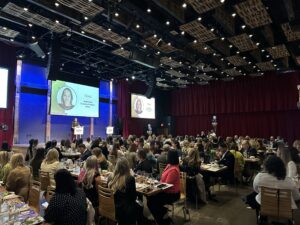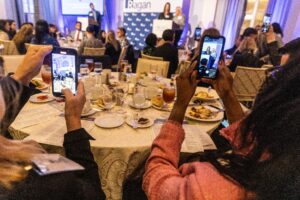Introducing the Ragan Communications Vanguard Awards
Every industry is driven by visionaries, innovators and trailblazers whose influence and leadership set new standards of excellence.

Ragan is spotlighting two individuals who have shepherded the future of PR and communications. Each year, two industry leaders — one representing external communications, the other internal communications — will be chosen as recipients of the Vanguard Awards for their career-long contributions to industry advancement.
Join us in congratulating the inaugural recipients of the 2024 Vanguard Awards, Tara Darrow and John Cirone.

Tara Darrow
Vice President, Corporate Communications
T-Mobile
Tara Darrow, Vice President, Corporate Communications, T-Mobile
Remember the Oscar-winning movie, “Everything, Everywhere, All At Once?” That title is a good summary of the state of external communications today.
“I can remember a time when we would fax a release out and then take a nice deep breath because we knew we had several hours, if not 24 to 36, to get a response,” said Darrow. “Now everything we do is almost instantaneous. It’s the same with media. News comes at any time – all hours, all days! Social media has changed everything we knew to be true. Anyone can be a ‘journalist’, hot tips and rumors can land anywhere, and the expectation for engagement is higher than ever. It’s made this career more exciting – the thing I love most about what I do is not knowing exactly what each day will bring – but it’s created some challenges for sure as well.”
As the leader of T-Mobile’s top-tier media engagement and storytelling, issues management, crisis communications, executive thought leadership, social amplification campaigns and much more, Darrow exemplifies the constantly pivoting communicator, meeting the demands for immediate action with a data-driven approach and the courage to stop and ask “why.”
Darrow quarterbacked the creation and execution of all external public relations and media strategies promoting and defending the $26 billion T-Mobile and Sprint merger (a three-year process that closed virtually during COVID), as well as other high-stakes initiatives around business and financial news, corporate responsibility, diversity and inclusion, reputation management and crisis communications, including the response to T-Mobile’s massive data breach, expertly helping guide leadership through a challenging time.
She has been key to producing powerful content around the growth of a bigger and better T-Mobile that’s focused on doing good for customers, employees and shareholders. For her efforts, Darrow has received T-Mobile’s prestigious PEAK Achievement Award, given to employees who have made exceptional contributions to the company and their teams.
As she looks ahead, Darrow obviously has eyes on AI but also the massive changes in the overall media landscape as well.
“We need to pay attention to the massive shift in media consumption that’s happening as well, particularly amongst the youngest generations,” she added. “Where they get their news, how it’s delivered to them and what they want to see has changed a lot (hello TikTok!) but this is just the tip of the iceberg. I already see media outlets experimenting in new ways to connect with audiences. It’s an exciting time to try new things as a communicator too.”

John Cirone
Senior Director, Global Employee and Executive Communications
Microsoft
John Cirone, Senior Director, Global Employee and Executive Communications, Microsoft
In an era where change is the only constant and a perennially updated resume is celebrated, John Cirone is a bit of a unicorn. In 2024, Cirone celebrated his 33rd year at Microsoft, a career that dates from the Bill Gates era through the tenure of Satya Nadella (Microsoft’s current CEO and just the third in its 50-year history).
When Cirone began with Microsoft in 1991, the company reached its 8,000 employees most effectively with a weekly printed newsletter delivered every Friday afternoon and an annual corporate get-together held at the Seattle Mariners’ baseball stadium.
Today, Cirone and a community of hundreds of executive and employee communicators employ a multi-channel approach of employee listening and two-way conversations to create experiences and communications for Microsoft’s nearly 220,000 employees, managers and senior leaders.
Sparked by Nadella’s desire to “change the soul of Microsoft,” Cirone and team replaced traditional channels like email, all-hands, and static intranet sites with new channels that allow for more open dialogue and connection between leaders and employees like Microsoft’s Viva Engage platform, or events like Ask Me Anything. Channels like these allow Microsoft’s leadership team to address topics employees care about in a timely fashion, helping to facilitate dialogue and create better connection.
Part of Microsoft’s engagement strategy is to empower all corporate communicators, not just those employees with “communications” in their title. Cirone and his team helped create and manage Microsoft’s Global Employee Experience Community [GEEC], a group of more than 1,000 employees, including senior leaders and their chiefs of staff, business managers, communications directors, social media managers and others who can help ensure leaders are aligned on messaging, foster use of new platforms internally, and extend the impact of centrally led communications into organizations and geographies across the world.
As for so many of us, the next frontier for Cirone and his team is AI. “This is not a change that is years away, it’s happening now, and will happen even more quickly than many of us expect,” said Cirone.
“As someone who isn’t a natural early adopter of new technology, I have had to fight my natural instincts and jump in here — testing our AI tools like Copilot, encouraging my team to make the space to experiment, and to be open to new ways of doing things,” he added. “It’s exciting to see, and I think it’s fantastic for the discipline of employee communications — which after years of being an undervalued part of the marketing profession — is finally being seen as a strategic and valuable part of a company’s marketing mix — that all of us who work in this profession know it to be.”






